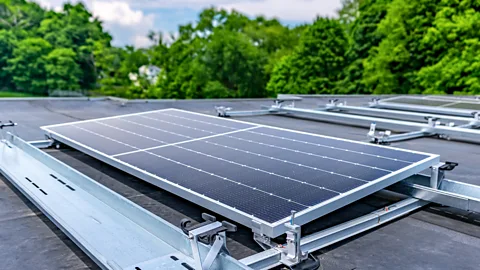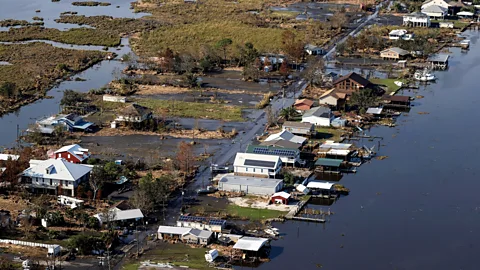Hurricane blackouts: New Orleans' 'lighthouse' solution to keep the power on through floods and high winds
 Getty Images
Getty ImagesAs Hurricane Francine leaves households without basic power in New Orleans, a handful of "community lighthouses" could offer a crucial lifeline.
On a Sunday in the Broadmoor neighbourhood of New Orleans earlier this year, a church full of voices can be heard singing the hymn This Little Light of Mine. But letting it shine has now taken on a whole new meaning for residents in the city. In 2023, the brownstone Broadmoor Church's rooftop was kitted out with a raft of new solar panels, turning that sunlight into energy for local residents.
The church is one of 86 planned "community lighthouses", and part of a wider project to build the nation's largest network of solar and storage resilience hubs at places of worship and community centres. The project is spearheaded by Together Louisiana, a non-profit organisation supported by local and federal funding, to transform these centres into energy-resilient hubs.
As Tropical Storm Francine, which made landfall as a category two hurricane, continues to inundate Louisiana, the need to adapt to such severe storms is growing. (Read more about how hurricanes are becoming more extreme with climate change.)
New Orleans' community lighthouses are in their early days, with 10 currently operational in the city, and are now facing their first major test. As of the early hours of 12 September, the grid was out in five of them. Speaking to the BBC earlier in the 2024 hurricane season, the project's organisers explained their plans for a life-saving model to provide crucial power in the immediate aftermath of a storm.
The community lighthouses function as solar-powered microgrids to provide power during grid failure and outages caused by extreme weather, such as hurricanes. The solar-power network also has back-up battery capacity, meaning the community can stay powered when conventional power sources are overcome by extreme winds and flooding.
"It takes just four of our batteries that store power from our solar panels to stay around 96% full and allow us to run for around a day when the grid goes down," the church's pastor and Broadmoor community lighthouse manager Gregory Manning says.
 Getty Images
Getty ImagesManning's church is part of a hub which will eventually serve 200 people from the surrounding area. During extreme weather, their daily electricity needs can be met – everything from small essentials like mobile phone charging to life-saving services, such keeping medicine cool and providing protection from extreme heat.
Louisiana locals say these community hubs can make a substantial difference during a hurricane. With an extremely active Atlantic hurricane season ramping up, it may not be long before the lighthouses are put to their first serious test.
Learning from Ida
Between 1980 and 2023, there were on average of 8.5 billion-dollar extreme weather events across the US. During 2019-2023, that figure more than doubled to 20.4 events a year.
Louisiana is in the top three states for the costliness of extreme weather and climate disasters since 1980 according to the National Oceanic and Atmospheric Administration (Noaa), behind Texas and Florida. However, Louisiana's smaller population and economy can make those costs especially hard to bear.
Overall, extreme weather has cost Louisiana $290bn (£225bn) since 1980. With these hazards now arriving in quicker succession, there's less time for recovery, Rob Verchick, professor of law at Loyola University, tells the BBC.
Mastering the microgrid
Systems capable of operating independently from the main power grid, known as microgrids, are gaining attention as extreme weather events become more frequent. The US military, for instance, aims to improve the power resilience of its bases a part of the Department of Defence's policy.
Microgrids currently provide less than 0.3% of the US's electricity but interest in them is growing for both environmental and practical reasons. The microgrid market is expected to grow significantly in the next years, particularly in Asia-Pacific and North America, with annual capacity installation and spending expected to climb fivefold between 2018 and 2027.
More than one million people were left without power after 2021's Hurricane Ida. Across the Gulf Coast, the most common cause of death from Ida was excessive heat during extended power outages.
"Hurricane Ida was a pivotal moment for the city," Manning says. "That taught us what we really needed to do, we realised that we have the power ourselves to get together a plan."
Founding member of Together Louisiana's community lighthouse project, Broderick Bagert says the neighbourhood felt "powerless" during Hurricane Ida. As he saw local government battle to try and provide the basics after the disaster, he and the team began to see how they could take matters into their own hands.
"Having been through this in Hurricanes Ida, Isaac, Katrina and Laura, we came to the conclusion that every neighbourhood needs one facility that has resilient power and can keep electricity when the grid goes down," says Bagert.
Energy for everybody
When a hurricane causes grid failure, the Broadmoor Church solar panels and back-up batteries operate off-grid, providing up to 20kW of power – enough to charge phones and run large refrigerators and freezers that can store 10,000lbs (450kg) of food.
But it's not just about these physical hubs, Bagert adds, as it is creating a community who can identify vulnerable individuals – the elderly, those living alone, or those without transport – and ensure they can access the resources they need. The aim is for each hub to be able to contact everyone in the network within 24 hours in the event of an extreme weather emergency.
"This starts from grassroots to try to get a response that becomes systemic, one that checks in on people in their neighbourhoods – we're in the early stages of developing this across our state," says Bagert.
 Getty Images
Getty ImagesBroadmoor Community Lighthouse was one of the first three to be completed in the planned lighthouse network. The Together Louisiana network includes civic centres and places of worship while also incorporating environmental and workers groups. The coalition says it is "deliberate about crossing the lines of race, religion, neighbourhood, and political affiliation" to help communities and build upon the places people already know and use frequently.
Almost one in four people live in poverty in New Orleans, which is twice the national average for America, making evacuation during extreme weather events untenable – many residents simply can't afford to. Manning says the lighthouses will be a "lifeline" for those "we know can't get out".
The financial toll of this extreme weather is heavy. Louisiana's largest power company estimated the damage repairs from hurricanes in 2020 and 2021 would cost more than $4bn (£3.1bn).
Last October, the federal government approved a $259m (£200m) grant to Louisiana to implement the community lighthouse project. It is the largest investment in grid resilience in the state's history and part of President Biden's biggest ever investment in the US electric grid, committing $3.46bn (£2.7bn) for 58 clean energy projects across 44 states.
Each community lighthouse uses four Tesla batteries for power storage, an automatic load control panel – replacing an electricity control panel from the 1950s – and two monitoring systems. They can also store excess solar energy in back-up batteries, and their energy efficiency is expected to reduce the Broadmoor community's utility costs by around $170,000 (£130,000) over the batteries' lifetimes – as well as reducing carbon emissions for the facility.
Life-saving electricity
Fatalities from knock-on effects of hurricanes have made up almost as many deaths as the immediate dangers of storm surge and flooding in the past 10 years in the US. In some storms, indirect effects outweigh direct effects. During Hurricane Ida, there were four direct and 26 indirect deaths in Louisiana, 13 of which were attributed to heat exhaustion due to the lack of air conditioning as the heat index reached 33C (92F).
To keep air conditioners on when the grid fails, conventional generators are often used. However, this can come with its own tragic consequences. Six indirect deaths during Hurricane Ida were due to carbon monoxide poisoning, which is a risk associated with generators.
New Orleans resident Cynthia Coleman lost two family members to carbon monoxide poisoning during the storm.
"The entire state was in darkness and my 54-year-old godmother and her grandchildren purchased a generator because it was so hot and they were just trying to survive," she says. It was their first time using the device, and Coleman's godmother and her godmother's 17-year-old grandson "went to sleep that night and didn't wake up". They had died from carbon monoxide poisoning caused by the generator.
Coleman says she believes the community lighthouses, with clean power, could have saved them. "They didn't have what they needed to be comfortable – basic electricity," she says. "I had to see coffins in the church."
She considers the lighthouses "priceless" in the face of extreme storms. "It eliminates the thought that another family member can suffer loss for situations should have been better handled," Coleman says. "I can't get them back but this encourages myself and my family that someone else will not have to experience what we did – it will help someone else."
When all 86 planned community lighthouse facilities are functioning, they will be stationed at no more than a 15-minute walking distance for the 380,000 residents of New Orleans.
When Hurricane Francine arrived, the operational lighthouses were charged and holding up well, with batteries providing much-needed power.
Asked about the state's future, Manning is cautious but hopeful.
"I wouldn't say confident, but I feel good about the steps we're taking and that we're making progress," he says. "More needs to be done and we need to move quickly – we have to catch up from the steps that we did not take over the past two years."
* This story was originally published on 7 August 2024, and updated with details on Hurricane Francine on 12 September 2024.
--
For essential climate news and hopeful developments to your inbox, sign up to the Future Earth newsletter, while The Essential List delivers a handpicked selection of features and insights twice a week.
